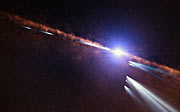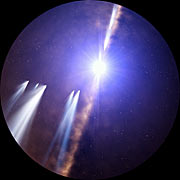Persbericht
Twee families van kometen gevonden rond nabije ster
Grote telling van exokometen rond Bèta Pictoris
22 oktober 2014
Het HARPS-instrument van de ESO-sterrenwacht op La Silla in Chili is ingezet voor de grootste telling van kometen rond een andere ster die ooit is ondernomen. Een Frans team van astronomen heeft bijna 500 afzonderlijke kometen onderzocht die om de ster Bèta Pictoris draaien. Daarbij is ontdekt dat de exokometen tot twee verschillende families behoren: oude exokometen die meerdere keren in de buurt van de ster zijn geweest, en jongere exokometen die waarschijnlijk afkomstig zijn van één of meer grotere objecten die recent uiteen zijn gevallen. De nieuwe resultaten verschijnen op 23 oktober 2014 in het tijdschrift Nature.
Bèta Pictoris is een jonge ster op ongeveer 63 lichtjaar van de zon. Hij is pas ongeveer 20 miljoen jaar oud en is omgeven door een enorme schijf van materiaal – een heel actief jong planetenstelsel waarin verdampende kometen en botsende planetoïden gas en stof produceren.
Flavien Kiefer (IAP/CNRS/UPMC), hoofdauteur van het nieuwe onderzoek, is enthousiast: ‘Bèta Pictoris is een heel spannend object! De gedetailleerde waarnemingen van zijn exokometen bieden ons aanknopingspunten die inzicht geven in de processen die in dit soort jonge planetenstelsels optreden.’
Al sinds bijna dertig jaar zien astronomen subtiele veranderingen in het licht van Bèta Pictoris die worden toegeschreven aan kometen die vanaf de aarde gezien vóór de ster langs trekken. Kometen zijn ijsachtige hemelobjecten met afmetingen van een paar kilometer die bij nadering van hun ster verdampen. Daarbij ontstaan reusachtige staarten van gas en stof die een deel van het sterlicht dat door hen heen gaat absorberen. Het zwakke licht van de exokometen zelf verbleekt bij het licht van de heldere ster, waardoor zij niet rechtstreeks waarneembaar zijn vanaf de aarde.
Om de exokometen van Bèta Pictoris te onderzoeken heeft het team meer dan duizend waarnemingen geanalyseerd die tussen 2003 en 2011 zijn verkregen met het HARPS-instrument van de 3,6-meter ESO-telescoop van de sterrenwacht op La Silla in Chili.
De onderzoekers vonden aanwijzingen voor 493 verschillende exokometen, waarvan sommige meerdere keren en gedurende enkele uren werden waargenomen. Nauwkeurige analyses leverden metingen op van de snelheid en de grootte van de gaswolken. Ook konden enkele baaneigenschappen van deze exokometen, zoals de vorm en de stand van de baan en de afstand tot de ster, worden afgeleid.
Deze analyse van honderden exokometen binnen één exoplanetenstelsel is uniek. Ze heeft aan het licht gebracht dat er sprake is van twee afzonderlijke families van exokometen: een familie van oude kometen waarvan de banen worden beteugeld door een zware planeet [1], en een familie die waarschijnlijk is voortgekomen uit het recent uiteenvallen van één of enkele grotere objecten. Ook in ons eigen zonnestelsel bestaan verschillende families van kometen.
De exokometen van de eerste familie vertonen een verscheidenheid aan banen, maar produceren niet veel gas en stof. Dit wijst erop dat hun ijsvoorraad door achtereenvolgende naderingen van Bèta Pictoris uitgeput is geraakt [2].
De exokometen van de tweede familie zijn veel actiever en volgen ook vrijwel identieke banen [3]. Dit wijst erop dat de leden van deze familie een gezamenlijke oorsprong hebben: waarschijnlijk een groter, uiteengevallen object waarvan de brokstukken een baan volgen die rakelings langs de ster gaat.
Flavien Kiefer concludeert: ‘Voor het eerst zijn middels statistisch onderzoek de fysische eigenschappen en banen van een groot aantal exokometen bepaald. Dit onderzoek biedt een opmerkelijke kijk op de processen die 4,5 miljard jaar geleden optraden in het pas gevormde zonnestelsel.’
Noten
[1] Met behulp van hogeresolutiebeelden, verkregen met adaptieve optiek, is ook een planeet ontdekt (Bèta Pictoris b) die op een afstand van ongeveer een miljard kilometer om de ster draait.
[2] Bovendien zijn de banen van deze kometen (qua excentriciteit en stand) precies zoals voorspeld voor kometen die in baanresonantie zijn met een zware planeet. De eigenschappen van de komeetbanen van de eerste familie laten zien dat deze planeet ongeveer 700 miljoen kilometer van de ster verwijderd moet zijn – niet ver van waar de planeet Bèta Pictoris b is ontdekt.
[3] In dat opzicht lijken ze op de kometen van de Kreutz-familie in ons zonnestelsel, of op de brokstukken van komeet Shoemaker-Levy 9, die in juli 1994 op Jupiter insloegen.
Meer informatie
De resultaten van dit onderzoek staan in het artikel ‘Two families of exocomets in the Beta Pictoris system’, dat op 23 oktober 2014 in het tijdschrift Nature zal verschijnen.
Het odnerzoeksteam bestaat uit F. Kiefer (Institut d’astrophysique de Paris [IAP], CNRS, Université Pierre & Marie Curie-Paris 6, Parijs, Frankrijk), A. Lecavelier des Etangs (IAP), J. Boissier (Institut de radioastronomie millimétrique, Saint Martin d’Hères, Frankrijk), A. Vidal-Madjar (IAP), H. Beust (Institut de planétologie et d'astrophysique de Grenoble [IPAG], CNRS, Université Joseph Fourier-Grenoble 1, Grenoble, Frankrijk), A.-M. Lagrange (IPAG), G. Hébrard (IAP) en R. Ferlet (IAP).
ESO is de belangrijkste intergouvernementele astronomische organisatie in Europa en de meest productieve sterrenwacht ter wereld. Zij wordt ondersteund door vijftien landen: België, Brazilië, Denemarken, Duitsland, Finland, Frankrijk, Italië, Nederland, Oostenrijk, Portugal, Spanje, Tsjechië, het Verenigd Koninkrijk, Zweden en Zwitserland. ESO voert een ambitieus programma uit, gericht op het ontwerpen, bouwen en beheren van grote sterrenwachten die astronomen in staat stellen om belangrijke wetenschappelijke ontdekkingen te doen. Ook speelt ESO een leidende rol bij het bevorderen en organiseren van samenwerking op astronomisch gebied. ESO beheert drie waarnemingslocaties van wereldklasse in Chili: La Silla, Paranal en Chajnantor. Op Paranal staan ESO’s Very Large Telescope (VLT), de meest geavanceerde optische sterrenwacht ter wereld, en twee surveytelescopen: VISTA werkt in het infrarood en is de grootste surveytelescoop ter wereld en de VLT Survey Telescope is de grootste telescoop die uitsluitend is ontworpen om de hemel in zichtbaar licht in kaart te brengen. ESO is ook de Europese partner van de revolutionaire telescoop ALMA, het grootste astronomische project van dit moment. Daarnaast bereidt ESO momenteel de bouw voor van de 39-meter Europese Extremely Large optical/near-infrared Telescope (E-ELT), die ‘het grootste oog op de hemel’ ter wereld zal worden.
Links
Contact
Alain Lecavelier des Etangs
Institut d'astrophysique de Paris (IAP)/CNRS/UPMC
France
Tel: +33-1-44-32-80-77
Mob: +33 6 21 75 12 03
E-mail: lecaveli@iap.fr
Flavien Kiefer
Institut d'astrophysique de Paris (IAP)/CNRS/UPMC and School of Physics and Astronomy, Tel Aviv University
France / Israel
Tel: +972-502-838-163
E-mail: kiefer@iap.fr
Richard Hook
ESO education and Public Outreach Department
Garching bei München, Germany
Tel: +49 89 3200 6655
Mob: +49 151 1537 3591
E-mail: rhook@eso.org
Rodrigo Alvarez (press contact België)
ESO Science Outreach Network
en Planetarium, Royal Observatory of Belgium
Tel: +32-2-474 70 50
E-mail: eson-belgië@eso.org
Over dit bericht
| Persberichten nr.: | eso1432nl-be |
| Naam: | Beta Pictoris |
| Type: | Milky Way : Star : Circumstellar Material : Disk |
| Facility: | ESO 3.6-metre telescope |
| Instruments: | HARPS |
| Science data: | 2014Natur.514..462K |
Our use of Cookies
We use cookies that are essential for accessing our websites and using our services. We also use cookies to analyse, measure and improve our websites’ performance, to enable content sharing via social media and to display media content hosted on third-party platforms.
ESO Cookies Policy
The European Organisation for Astronomical Research in the Southern Hemisphere (ESO) is the pre-eminent intergovernmental science and technology organisation in astronomy. It carries out an ambitious programme focused on the design, construction and operation of powerful ground-based observing facilities for astronomy.
This Cookies Policy is intended to provide clarity by outlining the cookies used on the ESO public websites, their functions, the options you have for controlling them, and the ways you can contact us for additional details.
What are cookies?
Cookies are small pieces of data stored on your device by websites you visit. They serve various purposes, such as remembering login credentials and preferences and enhance your browsing experience.
Categories of cookies we use
Essential cookies (always active): These cookies are strictly necessary for the proper functioning of our website. Without these cookies, the website cannot operate correctly, and certain services, such as logging in or accessing secure areas, may not be available; because they are essential for the website’s operation, they cannot be disabled.
Functional Cookies: These cookies enhance your browsing experience by enabling additional features and personalization, such as remembering your preferences and settings. While not strictly necessary for the website to function, they improve usability and convenience; these cookies are only placed if you provide your consent.
Analytics cookies: These cookies collect information about how visitors interact with our website, such as which pages are visited most often and how users navigate the site. This data helps us improve website performance, optimize content, and enhance the user experience; these cookies are only placed if you provide your consent. We use the following analytics cookies.
Matomo Cookies:
This website uses Matomo (formerly Piwik), an open source software which enables the statistical analysis of website visits. Matomo uses cookies (text files) which are saved on your computer and which allow us to analyze how you use our website. The website user information generated by the cookies will only be saved on the servers of our IT Department. We use this information to analyze www.eso.org visits and to prepare reports on website activities. These data will not be disclosed to third parties.
On behalf of ESO, Matomo will use this information for the purpose of evaluating your use of the website, compiling reports on website activity and providing other services relating to website activity and internet usage.
Matomo cookies settings:
Additional Third-party cookies on ESO websites: some of our pages display content from external providers, e.g. YouTube.
Such third-party services are outside of ESO control and may, at any time, change their terms of service, use of cookies, etc.
YouTube: Some videos on the ESO website are embedded from ESO’s official YouTube channel. We have enabled YouTube’s privacy-enhanced mode, meaning that no cookies are set unless the user actively clicks on the video to play it. Additionally, in this mode, YouTube does not store any personally identifiable cookie data for embedded video playbacks. For more details, please refer to YouTube’s embedding videos information page.
Cookies can also be classified based on the following elements.
Regarding the domain, there are:
- First-party cookies, set by the website you are currently visiting. They are stored by the same domain that you are browsing and are used to enhance your experience on that site;
- Third-party cookies, set by a domain other than the one you are currently visiting.
As for their duration, cookies can be:
- Browser-session cookies, which are deleted when the user closes the browser;
- Stored cookies, which stay on the user's device for a predetermined period of time.
How to manage cookies
Cookie settings: You can modify your cookie choices for the ESO webpages at any time by clicking on the link Cookie settings at the bottom of any page.
In your browser: If you wish to delete cookies or instruct your browser to delete or block cookies by default, please visit the help pages of your browser:
Please be aware that if you delete or decline cookies, certain functionalities of our website may be not be available and your browsing experience may be affected.
You can set most browsers to prevent any cookies being placed on your device, but you may then have to manually adjust some preferences every time you visit a site/page. And some services and functionalities may not work properly at all (e.g. profile logging-in, shop check out).
Updates to the ESO Cookies Policy
The ESO Cookies Policy may be subject to future updates, which will be made available on this page.
Additional information
For any queries related to cookies, please contact: pdprATesoDOTorg.
As ESO public webpages are managed by our Department of Communication, your questions will be dealt with the support of the said Department.







